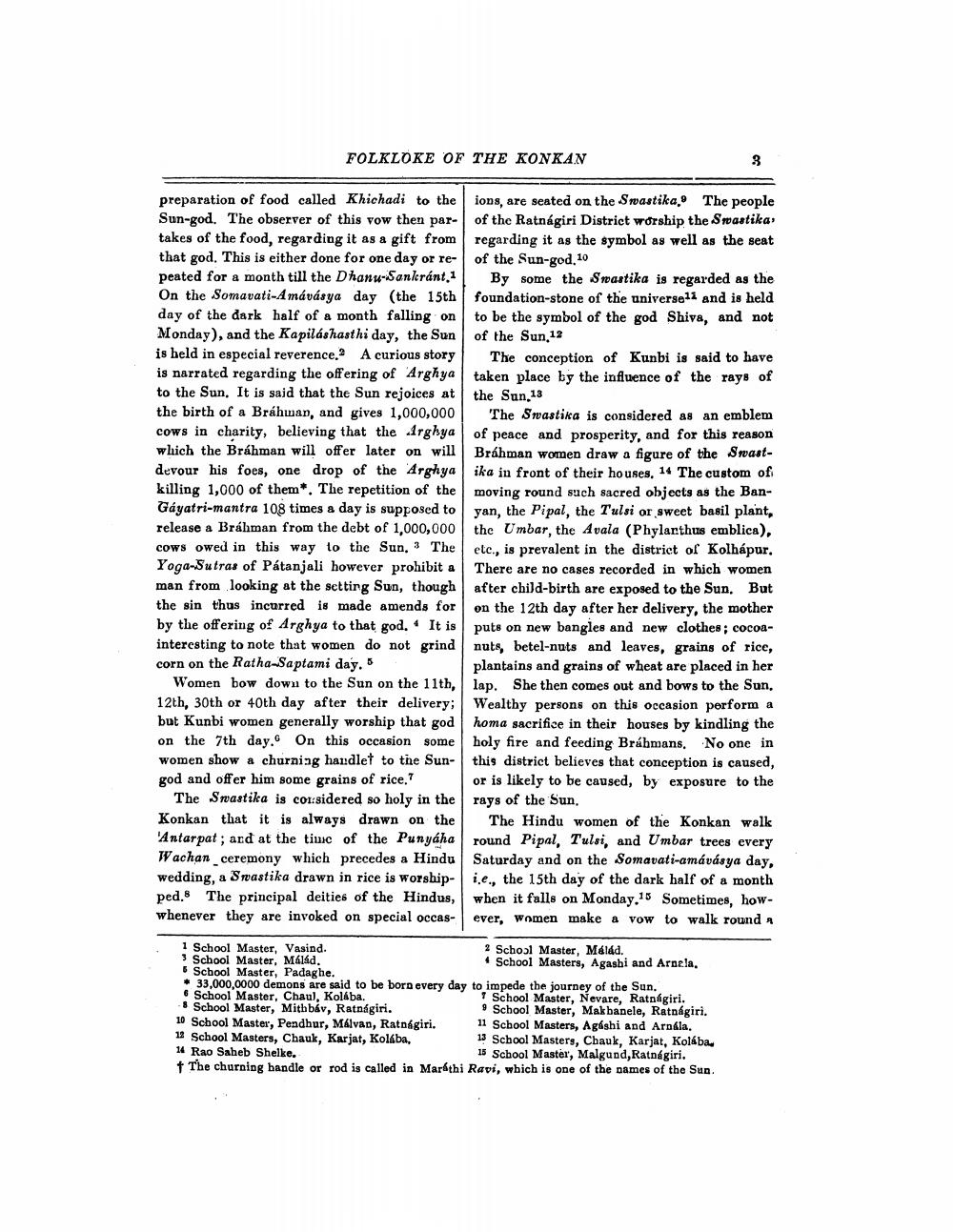________________
FOLKLOKE OF THE KONKAN
preparation of food called Khichadi to the ions, are seated on the Swastika. The people Sun-god. The observer of this vow then par- of the Ratnágiri District worship the Swastikas takes of the food, regarding it as a gift from regarding it as the symbol as well as the seat that god, This is either done for one day or re-l of the Sun-god.10 peated for a month till the Dhanu-Sankránt.1 By some the Swastika is regarded as the On the Somavati-Amávásya day (the 15th foundation-stone of the universeli and is held day of the dark half of a month falling on to be the symbol of the god Shiva, and not Monday), and the Kapiláshasthi day, the Sun of the Sun,12 is held in especial reverence. A curious story The conception of Kunbi is said to have is narrated regarding the offering of Arghya taken place by the influence of the rays of to the Sun. It is said that the Sun rejoices at the Sun.13 the birth of a Bráhman, and gives 1,000,000 "The Swastika is considered as an emblem cows in charity, believing that the Arghya of peace and prosperity, and for this reason which the Brahman will offer later on will Bráhman women draw a figure of the Swastdevour his foes, one drop of the Arghya ika in front of their houses, 14 The custom of killing 1,000 of them. The repetition of the moving round such sacred objects as the BanGayatri-mantra 108 times a day is supposed to yan, the Pipal, the Tulsi or sweet basil plant, release a Bráhman from the debt of 1,000,000 the Umbar, the Avala (Phylarthus emblica), cows owed in this way to the Sun, 3 The etc., is prevalent in the district of Kolhápur. Yoga-Sutras of Patanjali however prohibit a There are no cases recorded in which women man from looking at the setting Sun, though after child-birth are exposed to the Sun. But the sin thus incurred is made amends for on the 12th day after her delivery, the mother by the offering of Arghya to that god. It is puts on new bangles and new clothes; cocoainteresting to note that women do not grind nuts, betel nuts and leaves, grains of rice, corn on the Ratha Saptami day.
plantains and grains of wheat are placed in her Women bow down to the Sun on the 11th, lap. She then comes out and bows to the Sun. 12th, 30th or 40th day after their delivery; Wealthy persons on this occasion porform a but Kunbi women generally worship that god homa sacrifice in their houses by kindling the on the 7th day. On this occasion some holy fire and feeding Bráhmans. No one in women show a churniag handlet to the Sun- this district believes that conception is caused, god and offer him some grains of rice. or is likely to be caused, by exposure to the
The Swastika is considered so holy in the rays of the Sun. Konkan that it is always drawn on the The Hindu women of the Konkan walk 'Antarpat; ard at the time of the Punyáha round Pipal, Tulsi, and Umbar trees every Wachan ceremony which precedes a Hindu Saturday and on the Somavati-amávásya day, wedding, a Swastika drawn in rice is worship- ie, the 15th day of the dark half of a month ped. The principal deities of the Hindus, when it falls on Monday.15 Sometimes, howwhenever they are invoked on special occas- ever, women make a vow to walk round
1 School Master, Vasind.
2 School Master, Mélád. 3 School Master, Málád.
School Masters, Agashi and Arnela, 5 School Master, Padaghe. • 33,000,0000 demons are said to be born every day to impede the journey of the Sun. & School Master, Chau), Kolába.
1 School Master, Nevare, Ratnágiri. * School Master, Mithbáv, Ratnagiri.
School Master, Makbanele, Ratnagiri. 10 School Master, Pendhur, Málvan, Ratnagiri. 11 School Masters, Agáshi and Arnila. 12 School Masters, Chauk, Karjat, Kolába,
13 School Masters, Chauk, Karjat, Kolába. 14 Rao Saheb Shelke.
15 School Master, Malgund, Ratnagiri. The churning handle or rod is called in Marathi Ravi, which is one of the names of the Sun.




